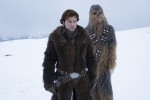“Solo: A Star Wars Story” builds Han Solo piece by piece but falls just shy of a compelling narrative.
As the second stand-alone film outside of the sequel trilogy, “Solo” chronicles the story of the galaxy’s favorite grizzled outlaw, Han Solo (Alden Ehrenreich), and his path from a hopeful young thief to a disillusioned smuggler. On his industrial home planet of Corellia, Solo enlists in the Imperial Army in order to earn enough credits to save his thievish love interest Qi’ra (Emilia Clarke), but is quickly thrown in jail for desertion. Seasoned bandit Tobias Beckett (Woody Harrelson) soon takes in Solo and his prison buddy Chewbacca (Joonas Suotamo), and introduces the pair to Dryden Vos (Paul Bettany), a cookie-cutter crime lord who hires the motley crew for a dangerous and potentially lucrative heist on which Solo meets young Lando Calrissian (Donald Glover) and his famed Millennium Falcon.
“Solo” hits nearly every mark it was expected to – action-packed chase sequences, sarcastic remarks from Solo and buddy humor with Chewbacca – but nearly all the action of the film feels driven toward building the character that Harrison Ford defined more than four decades ago.
While exposition is an essential aspect of any prequel, “Solo” clings to it as the film’s main goal, instead of telling a fresh and captivating story. Other than a series of predictable twists, the heist to steal a large amount of coaxium – a powerful and expensive starship fuel – encompasses nearly the entire film. Furthermore, the extended caper doesn’t seem to carry any real weight in the franchise besides explaining how Solo’s smuggling career began. Even Qi’ra seems to have only been created to help explain Solo’s disillusioned demeanor in “Star Wars: Episode IV – A New Hope.”
Despite its uninspired plot, “Solo” still employs the essential nostalgic elements, with authentic performances that allow for an ultimately endearing and amusing experience. While living up to Ford’s legacy was a nearly impossible task, Ehrenreich has clearly studied his predecessor, and persuasively embodies Solo’s characteristic wit and arrogance. For instance, when Calrissian jokingly tells Solo, “I hate you,” Solo quips back with “I know,” a twist on the famous line from the end of “Star Wars: Episode V – The Empire Strikes Back.”
The sentimentality continues with Solo’s mentor, Tobias, who essentially serves as the archetype that Solo grows into, even frequently calling Solo “kid,” a much-appreciated reference to Solo’s use of the term with Luke Skywalker. The gruff, distrusting character feels built for Harrelson, allowing him to slip seamlessly into the veteran smuggler’s shoes.
Despite his limited screen time, Glover radiates confidence as Calrissian, recreating Billy Dee Williams’ signature combination of charm and duplicity. Calrissian serves little purpose besides explaining how Solo came to own the Millennium Falcon, but is a welcome presence on screen nonetheless. He also brings along his courageous robot partner, L3-37 (Phoebe Waller-Bridge), a fierce fighter for the rights of her mechanical comrades, and one of many sources of comic relief throughout the film.
Quick-witted humor also permeates the interactions between Chewbacca and Solo, whose burgeoning friendship captures the spirit of the original “Star Wars” trilogy, and provides much of the enjoyment in the film. Over the course of the story, the duo slowly cements their relationship, from Solo telling Chewbacca his name is too long, to Chewbacca finally sitting next to Solo as his first mate in the Millenium Falcon. Although Solo’s inexplicable fluency in Shyriiwook aids their camaraderie, Chewbacca finally begins trusting the young thief after he helps free other Wookiees from enslavement on the planet Kessel.
The elements that led to the success of the first stand-alone movie, “Rogue One: A Star Wars Story,” are the same elements that prevent “Solo” from becoming a star. “Rogue One” was elevated by its ability to tell an original story that carried substantial weight within the Star Wars universe. The premise of “Solo,” however, provided considerably less autonomy.
Director Ron Howard was charged with creating an engaging and enjoyable film that could appeal to a wide audience, coincide with the “Star Wars” canon literature and also explain the origins of one of the most popular and distinctive characters in science fiction. Not surprisingly, the film’s narrative faltered, but Howard’s take on Han Solo’s origin story is still a fun romp from start to finish.

I think you nailed it with this review. I wasn’t disappointed in what I expected to be disappointed in, namely the casting and the cheesy nods to the original trilogy (looking at you, TFA). But I’ve come to expect the plotholes and embellishment of unnecessary scenes or characters from a Disney Star Wars film. Admittedly, I was more worried they were going to make me hate my favorite character from the original trilogy. While there still were cheesy nods, I applaud them for being much much more subtle than the new trilogy films, and *SPOILERS* they peaked my interest on the surprise character whom a lot of fans wished they had seen more of. While it may be a jump (despite the Clone Wars cartoon doing it first), I can at least appreciate and recognize their effort to listen to fans. I see this surprise character as like, an apology gift to the Star Wars Fandom after a big fight, haha.